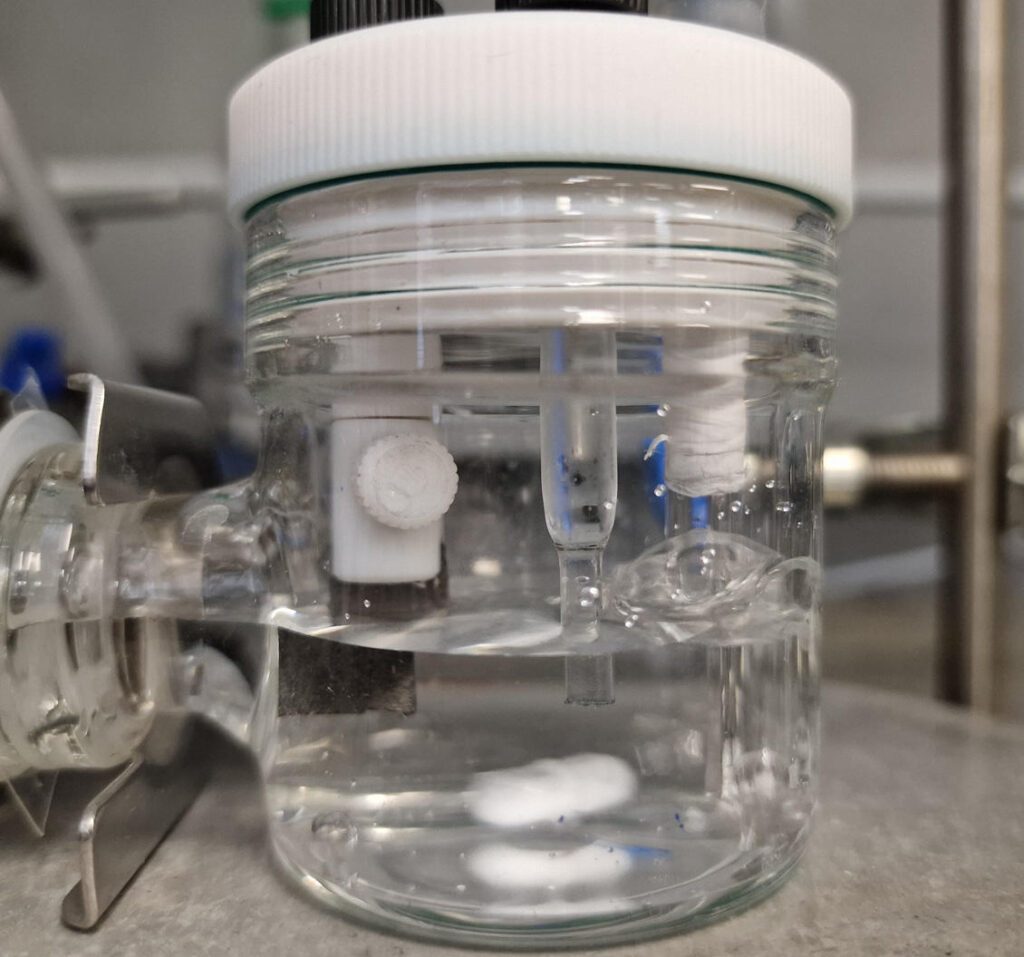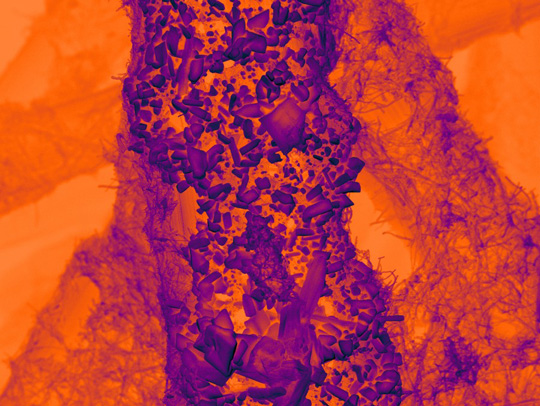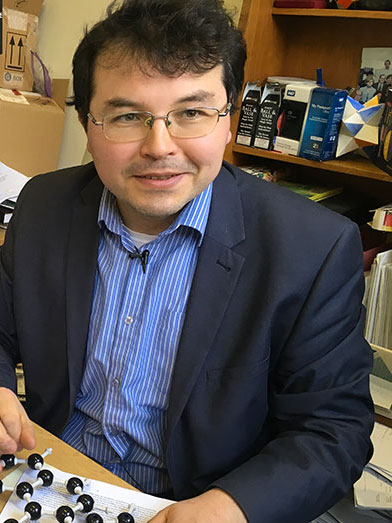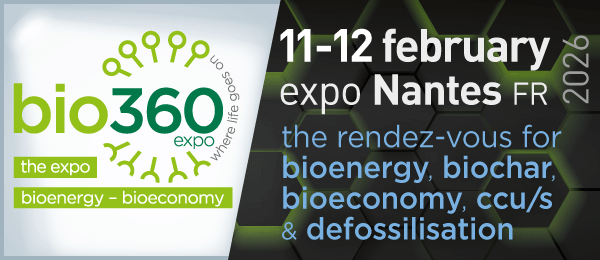
A collaborative team from the University of Nottingham’s School of Chemistry and the University of Birmingham have developed a catalyst made of tin microparticles supported by a nanotextured carbon structure. The interactions between the tin particles and graphitised carbon nanofibers play a critical role in transferring electrons from the carbon electrode to CO2 molecules – an essential step in converting CO2 into formate under an applied electric potential. The findings of this research are published in ACS Applied Energy Materials,
CO2 is the primary contributor to global warming. While CO2 can be converted into useful products, traditional thermal methods typically rely on hydrogen sourced from fossil fuels. Therefore, it is essential to develop alternative methods like electrocatalysis, which utilises sustainable energy sources, such as photovoltaics and wind power, as well as the abundant availability of water as a hydrogen source.
In electrocatalysis, applying an electric potential to the catalyst drives electrons through the material to react with CO2 and water, producing valuable compounds. One such product, formate, is widely used in the chemical synthesis of polymers, pharmaceuticals, adhesives, and more. For optimal efficiency, this process must operate at low potential while maintaining high current density and selectivity, ensuring effective use of electrons to convert CO2 to desired products.
Dr Madasamy Thangamuthu, a research fellow at the University of Nottingham co-led the research team, he said: “A successful electrocatalyst must strongly bond to the CO2 molecule and efficiently inject electrons to break its chemical bonds. We developed a new type of carbon electrode that incorporates graphitised nanofibers with a nanoscale texture, featuring curved surfaces and step edges, to enhance interaction with tin particles.”

Tom Burwell, a research assistant at the University of Nottingham undertook the work whilst studying at Centre for Doctorial Training in Sustainable Chemistry.
He developed the approach and carried out the experimental work, he said: “We can assess the performance of the catalyst by measuring the electrical current consumed by the reacting CO2 molecules. Typically, catalysts degrade during use, resulting in decreased activity. Surprisingly, we observed the current flowing through tin on nanotextured carbon increased continuously over 48 hours. Analysis of the reaction products confirmed nearly all electrons were utilised to reduce CO2 to formate, boosting productivity by a factor of 3.6 while maintaining nearly 100% selectivity.”
The researchers linked this self-optimisation to the tin microparticles breaking down into nanoparticles, as small as 3 nm, during the CO2 reduction reaction.
Tom Burwell elaborated: “Using electron microscopy, we found that smaller tin particles achieved better contact with the nanotextured carbon of the electrode, improving electron transport and increasing the number of active tin centres nearly tenfold.”
This transformative behaviour differs significantly from previous studies, where structural changes in catalysts are often seen as detrimental. Instead, the carefully engineered support in the catalyst developed by the Nottingham team allows for dynamic adaptation of tin and improved performance.

“CO2 is not only a well-known greenhouse gas but also a valuable feedstock for the production of chemicals. Consequently, designing new catalysts from earth-abundant materials like carbon and tin is vital for sustainable CO2 conversion and achieving the UK’s net-zero emissions target. Our catalysts must also remain active over extended use to ensure best value.” – Professor Andrei Khlobystov, School of Chemistry.
This discovery marks a step change in understanding the design of supports for electrocatalysis. By precisely controlling the interaction between the catalysts and their supports at the nanoscale, the team has laid the groundwork for highly selective and stable catalysts to convert CO2 into valuable products.
This work is funded by the EPSRC Programme Grant ‘Metal atoms on surfaces and interfaces (MASI) for sustainable future’ ( www.masi.ac.uk ), which is set to develop catalyst materials for the conversion of three key molecules – carbon dioxide, hydrogen and ammonia – crucially important for economy and environment. MASI catalysts are made in an atom-efficient way to ensure sustainable use of chemical elements without depleting supplies of rare elements and making most of the earth’s abundant elements, such as carbon and base metals.
The University of Nottingham is dedicated to championing green and sustainable technologies. The Zero Carbon Cluster has been recently launched in the East Midlands to accelerate the development and deployment of innovation in green industries and advanced manufacturing.
About the University of Nottingham
Ranked 32 in Europe and 16th in the UK by the QS World University Rankings: Europe 2024, the University of Nottingham is a founding member of the Russell Group of research-intensive universities. Studying at the University of Nottingham is a life-changing experience, and we pride ourselves on unlocking the potential of our students. We have a pioneering spirit, expressed in the vision of our founder Sir Jesse Boot, which has seen us lead the way in establishing campuses in China and Malaysia – part of a globally connected network of education, research and industrial engagement.
Nottingham was crowned Sports University of the Year by The Times and Sunday Times Good University Guide 2024– the third time it has been given the honour since 2018 – and by the Daily Mail University Guide 2024.
The university is among the best universities in the UK for the strength of our research, positioned seventh for research power in the UK according to REF 2021. The birthplace of discoveries such as MRI and ibuprofen, our innovationstransform lives and tackle global problems such as sustainable food supplies, ending modern slavery, developing greener transport, and reducing reliance on fossil fuels.
The university is a major employer and industry partner – locally and globally – and our graduates are the second most targeted by the UK’s top employers, according to The Graduate Market in 2022 report by High Fliers Research.
We lead the Universities for Nottingham initiative, in partnership with Nottingham Trent University, a pioneering collaboration between the city’s two world-class institutions to improve levels of prosperity, opportunity, sustainability, health and wellbeing for residents in the city and region we are proud to call home.
Source
University of Nottingham, press release, 2025-02-10.
Supplier
University of Birmingham
University of Nottingham
Share
Renewable Carbon News – Daily Newsletter
Subscribe to our daily email newsletter – the world's leading newsletter on renewable materials and chemicals













